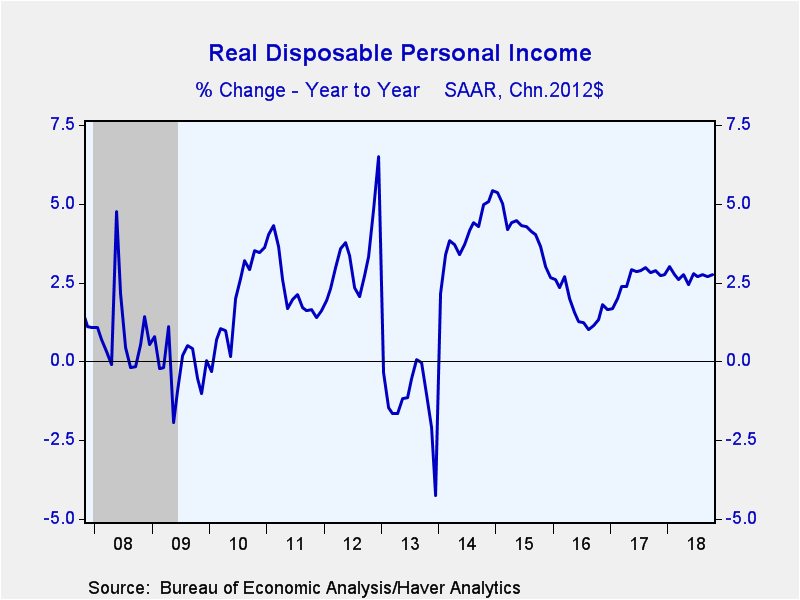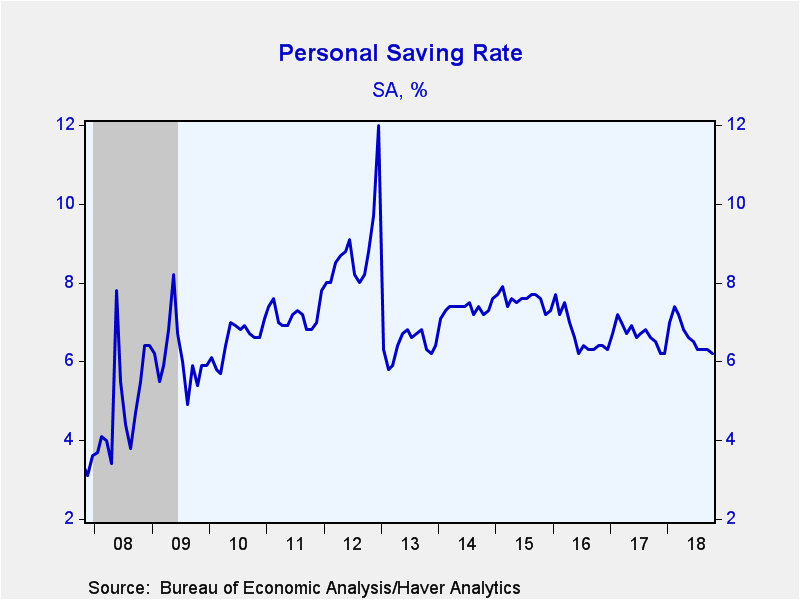 Global| Nov 29 2018
Global| Nov 29 2018U.S. Personal Income and Spending Heat Up; Core Pricing Cools
by:Tom Moeller
|in:Economy in Brief
Summary
Individuals seized the opportunity presented by improved earnings and easier pricing power to ramp up spending. Personal income rose 0.5% during October (4.3% y/y) following an unrevised 0.2% September gain. A 0.4% increase was [...]
Individuals seized the opportunity presented by improved earnings and easier pricing power to ramp up spending. Personal income rose 0.5% during October (4.3% y/y) following an unrevised 0.2% September gain. A 0.4% increase was expected in the Action Economics Forecast Survey. Leading last month's strength was a 1.6% jump (5.3% y/y) in proprietors' income as it rebounded from a 0.8% drop during September. Wages & salaries rose a steady 0.3% (4.4% y/y), slower than gains during the summer. Income from assets improved 0.4% (4.3 y/y) after a 0.1% uptick. It reflected a 0.5% dividend increase (3.8% y/y) and a 0.3% gain (4.6% y/y) in interest income. Rental income increased 0.4% (4.5% y/y) after stronger increases in the prior three months. Transfer payments rose 0.6% (4.4% y/y) reflecting a 1.0% strengthening (5.2% y/y) of social security payments, the largest increase since March. Medicare receipts rose 0.9% (6.8% y/y) and Medicaid income increased 0.6% (4.8% y/y). These strong gains were offset by a 2.4% decline (+11.9% y/y) in veterans benefits and a 2.1% drop (-16.4% y/y) in unemployment insurance benefits.
Personal consumption expenditures strengthened 0.6% last month (5.0% y/y) after a 0.2% September rise, revised down from 0.4%. It was the largest increase since March. A 0.4% rise had been expected. A 0.7% increase (5.2% y/y) in services outlays led the rise, the strongest increase since April 2016. Spending on housing & utilities rose 1.0% (4.9% y/y) as did financial services & insurance payments (5.4% y/y). Recreation services spending increased 0.5% (4.5% y/y) while spending at restaurants gained 0.3% (6.1% y/y). Health care outlays rose 0.3% (4.2% y/y), the weakest increase since February. Outlays on nondurable goods increased 0.6% (5.4% y/y) as fuel outlays rose 1.9% (15.1% y/y) with higher prices. Clothing spending gained 0.5% (4.6% y/y) and spending at restaurants rose 0.1% (3.5% y/y). Durable goods outlays increased 0.5% (2.7% y/y) led by a 0.7% rise (-1.8% y/y) in motor vehicle spending. Recreational goods & vehicle spending rose 0.5% (5.6% y/y) and home furnishings & appliance outlays gained 0.2% (4.9% y/y).
The personal savings rate eased to 6.2%, the lowest level since December. It has been falling steadily since the February high of 7.4%. The level of personal savings fell 1.0% y/y.
The personal consumption chain price index rose 0.2% (2.0% y/y) after four straight monthly increases. The index excluding food & energy rose 0.1%. The 1.8% y/y increase was the weakest since February and below the 2.0% rise three months earlier. The durable goods price index rose 0.1% (-1.4% y/y) following two months of decline. Recreational goods & vehicle prices fell 0.4% (-4.4% y/y) and "other" durable goods prices declined 1.0% (-3.4% y/y). Motor vehicle prices rose 0.6% both m/m and y/y and reversed September's decline. The nondurable goods price index gained 0.3% (2.0% y/y). Clothing prices eased 0.2% (-0.4% y/y) for the fourth month in the last five and food & beverage costs slipped 0.2% (+0.3% y/y). These declines were offset by a 2.9% jump (16.3% y/y) in gasoline & other energy product costs. Services prices rose 0.2% (2.5% y/y) led by a 0.4% gain (3.1% y/y) in housing & utility costs. Health care prices eased 0.1% (+1.4% y/y) and food service & accommodations prices fell 0.2% (+1.8% y/y).
The personal income and consumption figures are available in Haver's USECON database with detail in the USNA database. The Action Economics figures are in the AS1REPNA database.
The minutes to the latest FOMC meeting can be found here.
| Personal Income & Outlays (%) | Oct | Sep | Aug | Oct Y/Y | 2017 | 2016 | 2015 |
|---|---|---|---|---|---|---|---|
| Personal Income | 0.5 | 0.2 | 0.4 | 4.3 | 4.4 | 2.6 | 4.9 |
| Wages & Salaries | 0.3 | 0.3 | 0.5 | 4.4 | 4.6 | 2.9 | 5.1 |
| Disposable Personal Income | 0.5 | 0.2 | 0.4 | 4.8 | 4.4 | 2.8 | 4.4 |
| Personal Consumption Expenditures | 0.6 | 0.2 | 0.4 | 5.0 | 4.3 | 3.8 | 4.0 |
| Personal Saving Rate | 6.2 | 6.3 | 6.3 | 6.5 (Oct.'17) |
6.7 | 6.7 | 7.6 |
| PCE Chain Price Index | 0.2 | 0.1 | 0.1 | 2.0 | 1.8 | 1.1 | 0.3 |
| Less Food & Energy | 0.1 | 0.2 | 0.0 | 1.8 | 1.6 | 1.7 | 1.3 |
| Real Disposable Income | 0.3 | 0.1 | 0.3 | 2.8 | 2.6 | 1.7 | 4.1 |
| Real Personal Consumption Expenditures | 0.4 | 0.1 | 0.3 | 2.9 | 2.5 | 2.7 | 3.7 |
Tom Moeller
AuthorMore in Author Profile »Prior to joining Haver Analytics in 2000, Mr. Moeller worked as the Economist at Chancellor Capital Management from 1985 to 1999. There, he developed comprehensive economic forecasts and interpreted economic data for equity and fixed income portfolio managers. Also at Chancellor, Mr. Moeller worked as an equity analyst and was responsible for researching and rating companies in the economically sensitive automobile and housing industries for investment in Chancellor’s equity portfolio. Prior to joining Chancellor, Mr. Moeller was an Economist at Citibank from 1979 to 1984. He also analyzed pricing behavior in the metals industry for the Council on Wage and Price Stability in Washington, D.C. In 1999, Mr. Moeller received the award for most accurate forecast from the Forecasters' Club of New York. From 1990 to 1992 he was President of the New York Association for Business Economists. Mr. Moeller earned an M.B.A. in Finance from Fordham University, where he graduated in 1987. He holds a Bachelor of Arts in Economics from George Washington University.










